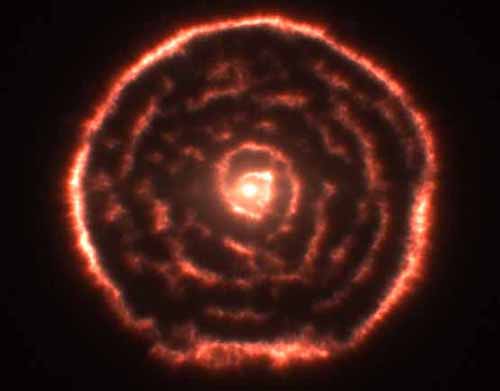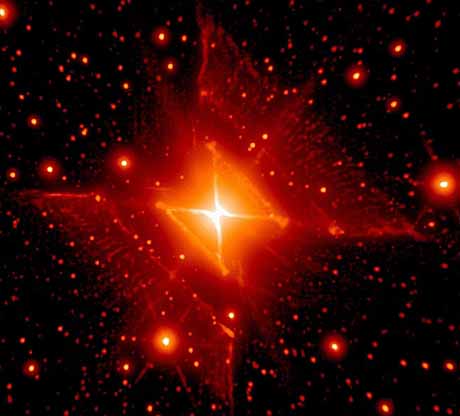
A Spiral Nebula Surrounding Star R Sculptoris NASA - October 17, 2012
An unusual spiral structure has been discovered around the Milky Way star R Sculptoris, a red giant star located about 1,500 light years away toward the constellation of the Sculptor (Sculptoris).
The star was observed with the new Atacama Large Millimeter/submillimeter Array (ALMA), the most powerful telescopic array observing near millimeter wavelengths, that part of the spectrum situated well beyond red light but before microwaves and radio waves. Data from ALMA observations was used to create a 3D visualization of the gas and dust immediately surrounding the star. A digital slice through this data showed the unexpected spiral structure.
Although unusual, a similar spiral pattern was discovered in visible light recently around LL Pegasi.
Upon analyzing the data, a hypothesis was drawn that the red giant star in R Sculptoris might be puffing gas toward an unseen binary companion star. The dynamics of this system might be particularly insightful because it may be giving clues as to how giant stars evolve toward the end of their lives - and so release some constituent elements back to the interstellar medium so that new stars may form.
Spiral Shell Sheds Light on Red Giant Star's Recent Convulsive History Scientific American - October 11, 2012
As stars age, they often shed their skins, so to speak, casting off expansive shells of dust and gas into interstellar space. A new look at the shell surrounding a type of aging star called a red giant shows that the star's ejected husk carries in its structure the imprint of its formation and subsequent evolution.
Matthias Maercker of the European Southern Observatory and the University of Bonn in Germany and his colleagues targeted R Sculptoris, a red giant star in the southern constellation of Sculptor, with the Atacama Large Millimeter/Submillimeter Array (ALMA). The radio telescope complex is already producing preliminary science, although it is still under construction in Chile's high-altitude Atacama Desert. ALMA will eventually consist of 50 widely spaced dish antennas, each of them 12 meters in diameter, plus a compact grouping of 16 additional dishes. As of last month 40 of the 66 planned antennas had been deployed. Data from the myriad dishes can be melded together by a computerized correlator to provide a single high-resolution radio image of an astronomical object.
The peek afforded by ALMA revealed that the shell around R Sculptoris is not spherical, as had been assumed, but has been twisted into a spiral, as depicted in the visualization of ALMA data above. Such spiral structure is thought to mark the presence of a stellar companion, so it now appears that R Sculptoris has an unseen binary partner. Maercker and his colleagues published the results of their observations in the October 11 issue of Nature. (Scientific American is part of Nature Publishing Group.)
The researchers could also infer from the shell's structure a timetable for its creation. R Sculptoris looks to have erupted the shell of material in a sort of stellar convulsion called a thermal pulse about 1,800 years ago. The thermal pulse lasted about 200 years, Maercker and his colleagues have concluded, during which time the star cast off about three times the mass of Jupiter in dust and gas.

Nebula